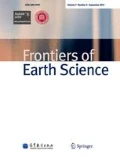Abstract
An improved synchronous fluorimetric method for the determination of dissolved organic matter in cave drip water, by adding ascorbic acid, is described. The method is based on the redox reaction between ascorbic acid and the electron-withdrawing constituents in dissolved organic matter. The results show that adding ascorbic acid can quench the minor peaks, at 200–300 nm, but does not affect the intensity of the main peaks at 300–500 nm. In addition, adding ascorbic acid can maintain relatively high and constant fluorescence intensity over a wide pH range (9-4).
Similar content being viewed by others
References
Arya S P, Mahajan M, Jain P (2000). Non-spectrophotometric methods for the determination of Vitamin C. Anal Chim Acta, 417(1): 1–14
Baker A (2005). Thermal fluorescence quenching properties of dissolved organic matter. Water Res, 39(18): 4405–4412
Baker A, Barnes W L, Smart P L (1996). Speleothem luminescence intensity and spectral characteristics: signal calibration and a record of palaeovegetation change. Chem Geol, 130(1–2): 65–76
Baker A, Genty D (1999). Fluorescence wavelength and intensity variations of cave waters. J Hydrol (Amst), 217(1–2): 19–34
Ban F, Pan G, Zhu J, Cai B, Tan M (2008). Temporal and spatial variations in the discharge and dissolved organic carbon of drip waters in Beijing Shihua Cave, China. Hydrol Processes, 22(18): 3749–3758
Blyth A J, Baker A, Collins MJ, Penkman K E H, Gilmour MA, Moss J S, Genty D, Drysdale R N (2008). Molecular organic matter in speleothems and its potential as an environmental proxy. Quat Sci Rev, 27(9–10): 905–921
Coble P G (1996). Characterization of marine and terrestrial DOM in seawater using excitation-emission matrix spectroscopy. Mar Chem, 51(4): 325–346
Gázquez F, Calaforra J M, Rull F, Forti P, García-Casco A (2012). Organic matter of fossil origin in the amberine speleothems from El Soplao Cave (Cantabria, Northern Spain). International Journal of Speleology, 41(1): 113–123
Hartland A, Fairchild I J, Lead J R, Baker A (2010). Fluorescent properties of organic carbon in cave dripwaters: effects of filtration, temperature and pH. Sci Total Environ, 408(23): 5940–5950
Hu C, Henderson G M, Huang J, Chen Z, Johnson K R (2008a). Report of a three-year monitoring programme at Heshang Cave, Central China. International Journal of Speleology, 37(3): 143–151
Hu C, Henderson G M, Huang J, Xie S, Sun Y, Johnson K R (2008b). Quantification of Holocene Asian monsoon rainfall from spatially separated cave records. Earth Planet Sci Lett, 266(3–4): 221–232
Hudson N, Baker A, Reynolds D (2007). Fluorescence analysis of dissolved organic matter in natural, waste and polluted waters—A review. River Res Appl, 23(6): 631–649
McGarry S F, Baker A (2000). Organic acid fluorescence: applications to speleothem palaeoenvironmental reconstruction. Quat Sci Rev, 19(11): 1087–1101
Miano T M, Martin J P, Sposito G (1988). Fluorescence spectroscopy of humic substances. Soil Sci Soc Am J, 52(4): 1016–1019
Mobed J, Hemmingsen S L, Autry J L, McGown L B (1996). Fluorescence characterisation of IHSS humic substances: total luminescence spectra with absorbence correction. Environ Sci Technol, 30(10): 3061–3065
Patel-Sorrentino N, Mounier S, Benaim J Y (2002). Excitation-emission fluorescence matrix to study pH influence on organic matter fluorescence in the Amazon basin rivers. Water Res, 36(10): 2571–2581
Senesi N, Miano T M, Provenzano M R (1991a). Fluorescence spectroscopy as a means of distinguishing fulvic and humic acids from dissolved and sedimentary aquatic sources and terrestrial sources. Humic Substances in the Aquatic and Terrestrial Environment, 33: 63–73
Senesi N, Miano T M, Provenzano M R, Brunetti G (1991b). Characterisation, differentiation and classification of humic substances by fluorescence spectroscopy. Soil Sci, 152(4): 259–271
van Beynen P, Bourbonniere R, Ford D, Schwarcz H (2001). Causes of colour and fluorescence in speleothems. Chem Geol, 175(3–4): 319–341
Xie S, Yi Y, Huang J, Hu C, Cai Y, Collins M, Baker A (2003). Lipid distribution in a subtropical southern China stalagmite as a record of soil ecosystem response to palaeoclimate change. Quat Res, 60(3): 340–347
Yang J, Tong C, Jie N, Zhang G, Ren X, Hu J (1997). Fluorescent reaction between ascorbic acid and DAN and its analytical application. Talanta, 44(5): 855–858
Author information
Authors and Affiliations
Corresponding author
Rights and permissions
About this article
Cite this article
Li, X., Hu, C., Liao, J. et al. An improved method for fluorescence analysis of dissolved organic matter in cave drip water. Front. Earth Sci. 8, 595–598 (2014). https://doi.org/10.1007/s11707-014-0439-6
Received:
Accepted:
Published:
Issue Date:
DOI: https://doi.org/10.1007/s11707-014-0439-6




